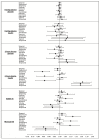Associations of Physical Behaviours and Behavioural Reallocations with Markers of Metabolic Health: A Compositional Data Analysis
- PMID: 30336601
- PMCID: PMC6210541
- DOI: 10.3390/ijerph15102280
Associations of Physical Behaviours and Behavioural Reallocations with Markers of Metabolic Health: A Compositional Data Analysis
Abstract
Standard statistical modelling has shown that the reallocation of sitting time to either standing or stepping may be beneficial for metabolic health. However, this overlooks the inherent dependency of time spent in all behaviours. The aim is to examine the associations between physical behaviours and markers of metabolic health (fasting glucose, fasting insulin, 2-h glucose, 2-h insulin, Homeostasis Model Assessment of Insulin Sensitivity (HOMA-IS), Matsuda Insulin Sensitivity Index (Matsuda-ISI) while quantifying the associations of reallocating time from one physical behaviour to another using compositional analysis. Objectively measured physical behaviour data were analysed (n = 435) using compositional analysis and compositional isotemporal substitutions to estimate the association of reallocating time from one behaviour to another in a population at high risk of type 2 diabetes mellitus (T2DM). Stepping time was associated with all markers of metabolic health relative to all other behaviours. Reallocating 30 min from sleep, sitting, or standing to stepping was associated with 5⁻6 fold lower 2-h glucose, 15⁻17 fold lower 2-h insulin, and higher insulin sensitivity (10⁻11 fold via HOMA-IS, 12⁻15 fold via Matsuda-ISI). Associations of reallocating time from any behaviour to stepping were maintained for 2-h glucose, 2-h insulin, and Matsuda-ISI after further adjusting for body mass index (BMI). Relocating time from stepping into sleep, sitting, or standing was associated with lower insulin sensitivity. Stepping time may be the most important behavioural composition when promoting improved metabolic health in adults at risk of T2DM.
Keywords: metabolic health; physical activity; sedentary behaviour; sleep; time use.
Conflict of interest statement
The authors declare no conflict of interest.
Figures
Comment in
-
Isotemporal Substitution as the Gold Standard Model for Physical Activity Epidemiology: Why It Is the Most Appropriate for Activity Time Research.Int J Environ Res Public Health. 2019 Mar 5;16(5):797. doi: 10.3390/ijerph16050797. Int J Environ Res Public Health. 2019. PMID: 30841555 Free PMC article.
-
Reply to Mekary, R.A.; Ding, E.L. Isotemporal Substitution as the Gold Standard Model for Physical Activity Epidemiology: Why It Is the Most Appropriate for Activity Time Research. Int. J. Environ. Res. Public Health 2019, 16, 797.Int J Environ Res Public Health. 2019 Aug 12;16(16):2885. doi: 10.3390/ijerph16162885. Int J Environ Res Public Health. 2019. PMID: 31409046 Free PMC article.
References
-
- Tremblay M.S., Aubert S., Barnes J.D., Saunders T.J., Carson V., Latimer-Cheung A.E., Chastin S.F.M., Altenburg T.M., Chinapaw M.J.M. Sedentary Behavior Research Network (SBRN)—Terminology Consensus Project process and outcome. Int. J. Behav. Nutr. Phys. Act. 2017;14:75. doi: 10.1186/s12966-017-0525-8. - DOI - PMC - PubMed
Publication types
MeSH terms
Substances
LinkOut - more resources
Full Text Sources
Medical


